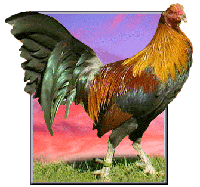Breed: Old English Game
Temperament: Aggressive, active
Cost: from $50 per bird
Lifespan: 12 years
Recommended for: Experienced poultry keepers
Appearance: Old English Game cocks are long-legged, muscular and full-breasted with spectacular colouring and tail feathers. Combs and wattles are traditionally dubbed (cropped). Hens resemble the males but are slightly smaller and lack the colour and lavish tail feathers.
Cocks stand 38-41cm (15-16″) and weigh 2-2.5kg (5-5.5lb). Old English Game are grouped in colours such as Black Red, Blue Red, Grey, Piles, Dun, Black, and White. Many unusual colours have died out although some isolated populations may exist.
Today there are basically two types: one known as the Oxford which is extremely active, tends to stand up more, and has a large flowing tail. The Carlisle tends to have a slightly more horizontal stance and is more heavily muscled.
Temperament: Old English Game fowl tend to be aggressive and it’s essential to separate the male birds from each other fairly early in life. Birds often need to be separated from their neighbours by sheets of tin to prevent fights. The birds can, and will, peck and spur humans and should be carefully watched at all times. The gameness of the bird is considered an integral feature of the breed by enthusiasts.
Cost: Good birds cost from $50 to $100 for a top quality cock. Some exhibition birds have sold to $800.
Health: Birds should be vaccinated regularly and their cage, food and water kept clean and well maintained.
Breeding: Breeders say Old English Game hens can make excellent mothers.
Feeding: Most breeders feed their fowl a mixture of millet and wheat as well as some protein supplements.
Housing: Secure housing is critical. It is usual to group two hens and a rooster separating these from other groups with a sheet of tin or fibreboard as the birds can even fight through the wire. If one bird should take a dislike to a cage mate, that mate should be removed immediately before it is pecked to death.
Housepet potential: Given its aggressive nature this is not a recommended household pet (always check council bylaws; many do not allow roosters to be kept in a suburban backyard).
Ideal owner: Old English Game are not recommended for children under eight years of age, and older children should be taught how to handle the bird correctly. This is a breed for the enthusiast.
Uses: If you enjoy poultry with a gamy texture and flavour, the Old English Game is said to make good eating. Breeders we spoke with dressed their birds when three to four months old. While not a recognised laying breed, a hen could produce up to 140 eggs a year.
Origin/History: The Old English Game fowl represents among the oldest strains of the world’s purpose-bred fighting birds and fighting cocks were used to incite Roman soldiers as they went into battle. Later English nobility developed a wide range of colours and patterns to identify their particular strain of fighting bird. Cockfighting became illegal in England in 1849 and in Australia in 1850.
Cockfighting is a serious offence in all Australian states with people involved being liable for prosecution under the cruelty to animals act. In some states even possessing cockfighting spurs is an offence.
In Australia today, Old English Game are kept by exhibition enthusiasts who aim to preserve the traditional lines, colours and stature of the fighting bird.
Further information
NSW
Breeder: Dr Robin Cumming
Rockpool
1234 Rockvale Road
Armidale, 2350
Phone: (02) 6775 1785
National
Oxford Gamefowl Breeder’s Association of Australia
Secretary: Jack O’Sullivan
Phone: (07) 3812 1325
Oxford Old English Game Fancier’s Association of Australia
Secretary: Wayne Flint
58 Tralga Road
Goulburn, NSW, 2580
Old English Game Fowl Club of Australia
Keith Dubber
Lot 2 Brunswick Road
Mullumbimby, NSW, 2482
Phone: (02) 6684 1423



